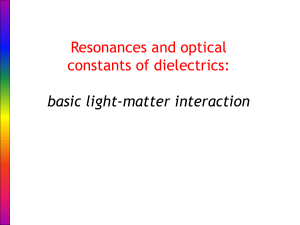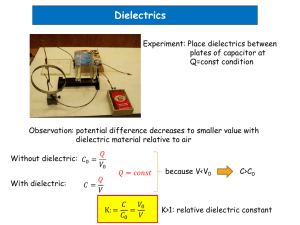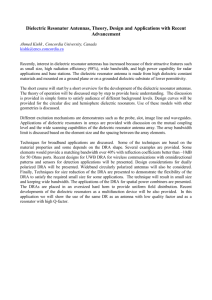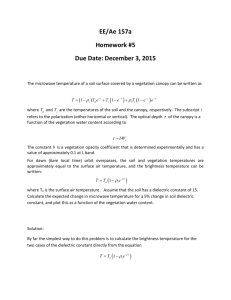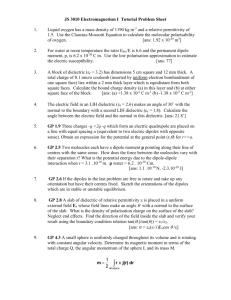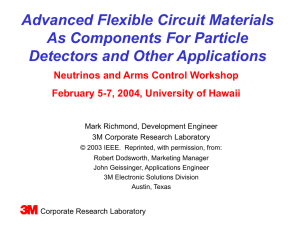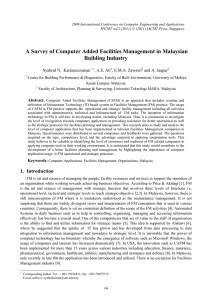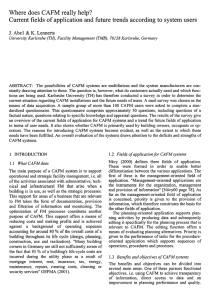Boron nitride as two dimensional dielectric: reliability and dielectric
advertisement
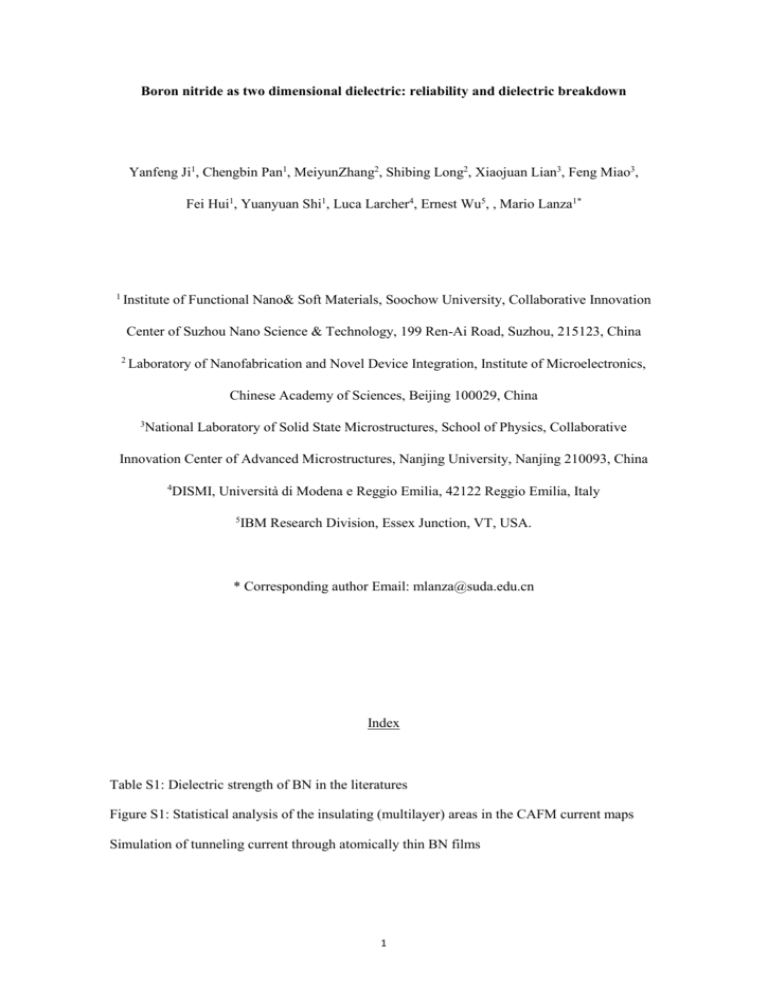
Boron nitride as two dimensional dielectric: reliability and dielectric breakdown Yanfeng Ji1, Chengbin Pan1, MeiyunZhang2, Shibing Long2, Xiaojuan Lian3, Feng Miao3, Fei Hui1, Yuanyuan Shi1, Luca Larcher4, Ernest Wu5, , Mario Lanza1* 1 Institute of Functional Nano& Soft Materials, Soochow University, Collaborative Innovation Center of Suzhou Nano Science & Technology, 199 Ren-Ai Road, Suzhou, 215123, China 2 Laboratory of Nanofabrication and Novel Device Integration, Institute of Microelectronics, Chinese Academy of Sciences, Beijing 100029, China 3 National Laboratory of Solid State Microstructures, School of Physics, Collaborative Innovation Center of Advanced Microstructures, Nanjing University, Nanjing 210093, China 4 DISMI, Università di Modena e Reggio Emilia, 42122 Reggio Emilia, Italy 5 IBM Research Division, Essex Junction, VT, USA. * Corresponding author Email: mlanza@suda.edu.cn Index Table S1: Dielectric strength of BN in the literatures Figure S1: Statistical analysis of the insulating (multilayer) areas in the CAFM current maps Simulation of tunneling current through atomically thin BN films 1 Dielectric strength of BN in the literatures After literature resources, different setups have been used for characterizing the dielectric strength of BN. They are based on measuring an I-V curve and calculation of the electric field (EBD) at which the BD is triggered or, by other words, at which the voltage VBD across the dielectric thickness (d) induces the BD: (EBD=VBD/d) . Notably, the dielectric strength depends on the quality of the insulator, but also on the cross sectional area between the electrodes at which the test is performed. As the dielectric breakdown is a stochastic process that always takes place at the weakest location of the sample, larger areas may produce a reduction on the dielectric strength, as there are more probabilities to find a weak spot. Therefore, some values may not be comparable. In the table below we summarize the values and setups found in the literatures. Fabrication Method Setup Area BN field (MV/cm) Reference Mechanical exfoliation CAFM ~ 100nm2 7.94 Appl. Phys. Lett. 2011, 99, 243114 Mechanical exfoliation CAFM ~ 100nm2 ~12 ACS Nano. 2015, 9(1), 916–921 Mechanical exfoliation CAFM ~ 100nm2 10 NanoLett. 2012, 12, 1707−1710 Mechanical exfoliation Probestation Ti/Au electrodes (1000 μm2) 6.4 - 9.0 Carbon 2013, 54, 396−402 CVD Probestation Au electrodes (18 mm x 200 µm) ~9.0 Nano Res. 2013, 6(7), 602–610 CVD Probestation Ti/Au electrodes (5 μm x 5 μm) 1.5 - 2.5 ACS Nano. 2012, 6, 8583–8590 Magnetron sputtering Probestation Ru electrodes (3 μm2) * NanoLett. 2013, 13, 276−281 Table S1: Dielectric strength of BN films reported in the literatures. The symbol "*" indicates that the paper doesn't give a value for the dielectric strength, but it shows that the tunneling conductance of sputtered BN is similar to that of exfoliated one, which is also a relevant information for comparing the quality of the films. 2 Statistical analysis of the insulating (multilayer) areas in the CAFM current maps Figure S1: Statistical analysis of the current map via CAFM software. The software provides information on the total area covered by the hills (locations that show large currents), which is 81.97% (red dashed rectangle). The software also provides additional information such as hills volume. The parameter "Number of Hills" is not representative in this study due to the nucleation of different hills. Simulation of tunneling current through atomically thin BN films In order to understand the dielectric properties of atomically thin BN films, the current through the tip/sample nanojunction is simulated using the charge transport model reported in [ref. S1S3]. This tunneling charge transport model across dielectric layers presented in reference accounts for both intrinsic (e.g. direct tunneling, thermionic emission, drift and diffusion) and defect-assisted tunneling (e.g. Trap-Assisted Tunneling, Poole-Frenkel, hopping) contributions. 3 In the case of atomically thin layer, the direct tunneling (DT) results to be the main contribution. The electron DT current from the metal gate is computed using the Tsu-Esaki formula [ref. S5]. The tunneling probabilities are calculated using the Wentzel-Kramer-Brillouin (WKB) method. The electric field across the stack is calculated by solving the 3D Poisson equation, which consistently includes the defect and charge trapping contributions. The TAT current is modeled using a multi-scale approach including for electron-phonon coupling and lattice relaxation, which rely on the atomic description of defect properties such as thermal ionization and relaxation energies. Contributions of conductive paths comprising more than one defects [ref. S2]are automatically included. More details about the physics related to the model can be found in references [ref. S1-S6].For the calculation presented in Figure 1e of the manuscript, a 10 nm × 10 nm squared Pt/BN/Cu heterojunction is considered. The size is chosen to match the typical tip/sample contact area for an AFM working in air environment and using similar tips, which ranges between 50 and 100 nm2. The work function of the Pt has been selected to be 5 to match the properties of the PtIr CAFM tip, while for Cu and BN we consider the standard work function values of 4.9eV and 4.5eV. The current across the real system is calculated depending on the potential difference applied between the Pt electrode and the Cu substrate. We found that, the currents observed in the trace plot (Figure 1e in the manuscript) for each thickness, agree with the values measured, and also with those reported in the literature. The calculations match better the experiments when including the contribution of the capillary layer (1nm H2O between the tip and the sample), which simulates the real system. The current values also fit the layer-bylayer progressive BD in Figure 3a. [ref. S1] Herrmann, M. R.; Schenk, A. J. Appl. Phys. 1995, 77, 4522. [ref. S2] Larcher, L. IEEE Trans. Electron Devices2003, 50, 1246. [ref. S3] Padovani, A. Proc. IEEE Int. Rel. Phys. Symp.2008, 55, 616. [ref. S4] Yang, N.; Henson, W. K.; Hauser, J. R.; Wortman, J. J. IEEE Trans. Electron Dev.1999, 46, 1464. [ref. S5] Duke, C. B. Academic Press, 1969. [ref. S6] Larcher, L.; Pavan, P.; Pellizzer, F.; Ghidini, G. IEEE Trans. Electron Devices, 2001, 48, 935. 4
